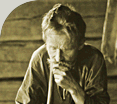|
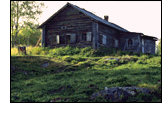 Vuonninen
can well be considered on a par with Latvajärvi in importance
as a bardic village in Viena. This status derives from two bards
in particular, Ontrei Malinen and Vaassila Kieleväinen. Vuonninen
can well be considered on a par with Latvajärvi in importance
as a bardic village in Viena. This status derives from two bards
in particular, Ontrei Malinen and Vaassila Kieleväinen.
Ontrei Malinen
When Lönnrot met Ontrei Malinen in the autumn of 1833, the
latter was the most accomplished bard he had yet encountered. It
was from Ontrei that Lönnrot recorded the Sampo Episode, The
Singing Match, Fishing for Vellamo's Fair Maiden, Väinämöinen
and Antero Vipunen, The Rivals, The Sailing Expedition Against Pohjola
and the Creation of the Kantele, Lemminkäinen's Tale and Väinämöinen's
Judgement. These poems comprise a total of 806 lines.
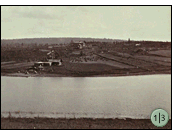 Vaassila
Kieleväinen Vaassila
Kieleväinen
Ontrei's poems were of course valuable as such to Lönnrot;
it was discussions with Vaassila Kieleväinen that provided
Lönnrot with an entirely new dimension in poetry collecting
- the idea of creating an epic. Lönnrot tells of this insight
for the first time in a letter to Dr. Henrik Cajander dated 3 December
1833:
I intend to visit the Archangel District (Viena) again this
winter and will not stop collecting poems until I have a collection
half as long as Homer. The poems I have are all part of the same
whole, at least according to a man I met who both sang to me and
told me about Väinämöinen.
When Lönnrot met Vaassila, the latter was already quite old
and better known as a shaman and master of spells than as an epic
bard. In addition, according to Lönnrot, Kieleväinen's
memory had deteriorated a great deal in recent years.
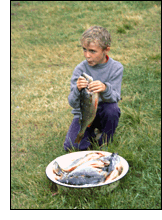 In
their interview, Vaassila spoke more than sang about the content
of the poems and the order in which they were presented. When Vaassila
had forgotten a particular detail that Lönnrot was aware of
from his other work, Lönnrot helped him recall it and they
went on. In sum, Lönnrot says: "...and so I found out
about all of Väinämöinen's deeds in one sitting and
have organized the extant poems about him accordingly." In
their interview, Vaassila spoke more than sang about the content
of the poems and the order in which they were presented. When Vaassila
had forgotten a particular detail that Lönnrot was aware of
from his other work, Lönnrot helped him recall it and they
went on. In sum, Lönnrot says: "...and so I found out
about all of Väinämöinen's deeds in one sitting and
have organized the extant poems about him accordingly."
Sjögren (1825) had had an opportunity to listen to Ontrei
Malinen before Lönnrot did, but Lönnrot did not have access
to Sjögren's notes until he was working on the second edition
of the Kalevala.
Lönnrot visited Vuonninen himself once, on his fifth field
trip, but only spent a few hours there. In two or three hours, he
recorded the poems "some woman had volunteered to sing to me".
He also relates that he stopped in to greet Ontrei Malinen before
continuing his journey that night by sledge to Jyvöälahti.
On his seventh field trip, Lönnrot visited Vuonninen again,
this time accompanied by J.F. Cajan. The two arrived in the village
on Saturday 22 October (1836) and continued their journey on the
following Monday. Cajan tells us how they spent the Sunday: "...we
watched contests between the boys and girls, chatted with the men
who had gathered there, sang verses from the Kalevala and then went
to bed."
The next poetry collector to visit Vuonninen (1839) was M.A. Castrén,
who says that he 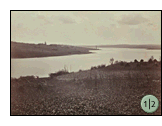 recorded
quite a selection of spells, myths, and folk tales. He also met
Vaassila Kieleväinen, who, breaking with the shaman tradition,
revealed to Castrén a number of his tricks and the implements
he used to perform them. recorded
quite a selection of spells, myths, and folk tales. He also met
Vaassila Kieleväinen, who, breaking with the shaman tradition,
revealed to Castrén a number of his tricks and the implements
he used to perform them.
Other poems from Vuonninen that figured in the second edition of
the Kalevala were those recorded by Europaeus in the winter of 1845-46.
The next generation of poetry collectors came to listen to bards
who had inherited their craft from Ontrei Malinen and Vaassila Kieleväinen;
most were members of the Malinen family that "ruled" Vuonninen.
Among those considered to be the best were Ontrei's son Ontreini
Jyrki and Homani Ohvo, both of whom Berner captured in the same
photograph in 1872.
When Borenius and Berner visited Vuonninen in 1872, they were accompanied
by Genetz, who had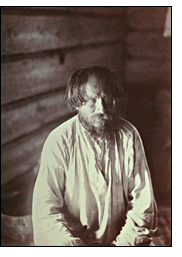 a bard named Tanila Kieleväinen sing poems for him. It is not
known what relation, if any, Tanila was to Vaassila.
a bard named Tanila Kieleväinen sing poems for him. It is not
known what relation, if any, Tanila was to Vaassila.
Anni Lehtonen
Although unrivalled in their cultural historical significance as
bards, Ontrei and Vaassila were surpassed in terms of sheer quantity
of folklore provided by Anni Lehtonen. Anni, who lived much later
than Ontrei and Vaassila, was the "discovery" of folklorist
Samuli Paulaharju. She contributed over 4,500 lines of the poetry
recorded in the Ancient Poems of the Finnish People.
Most of the poems Anni provided were spells. These were 250 in
number, totalling 2,700 lines. She remembered little epic poetry
- a mere three lines of the Sampo cycle, for example. However, she
did provide Paulaharju with a large number of lamentations, proverbs
and children's songs..
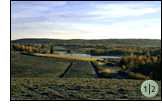 Anni
Lehtonen was the product of three of the great bardic families.
Her mother Okahvie was the niece of Ontrei Malinen; her maternal
grandmother was the daughter of Pietari Kettunen of the village
of Tšena; and her father was from the Karjalainen family in
the village of Lonkka (the nephew of Martiska Karjalainen). Anni
Lehtonen was the product of three of the great bardic families.
Her mother Okahvie was the niece of Ontrei Malinen; her maternal
grandmother was the daughter of Pietari Kettunen of the village
of Tšena; and her father was from the Karjalainen family in
the village of Lonkka (the nephew of Martiska Karjalainen).
Vuonninen
What to see
Panorama
|
